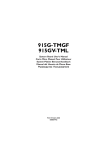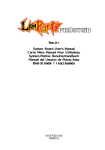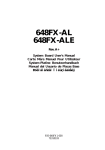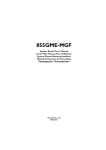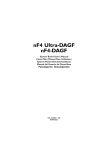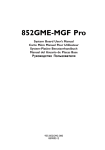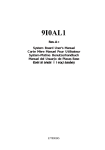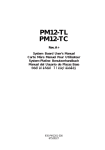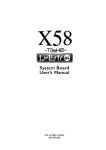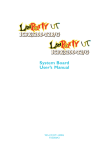Download DFI 875P Infinity Motherboard
Transcript
System Board User’s Manual Carte Mère Manuel Pour Utilisateur System-Platine Benutzerhandbuch Manual del Usuario de Placas Base Ðóêîâîäñòâî Ïîëüçîâàòåëÿ 935-875P01-000 82700429 Quick Setup Guide 1 Quick Setup Guide Copyright This publication contains information that is protected by copyright. No part of it may be reproduced in any form or by any means or used to make any transformation/adaptation without the prior written permission from the copyright holders. This publication is provided for informational purposes only. The manufacturer makes no representations or warranties with respect to the contents or use of this manual and specifically disclaims any express or implied warranties of merchantability or fitness for any particular purpose. The user will assume the entire risk of the use or the results of the use of this document. Further, the manufacturer reserves the right to revise this publication and make changes to its contents at any time, without obligation to notify any person or entity of such revisions or changes. © 2004. All Rights Reserved. Trademarks Windows ® 98SE, Windows ® ME, Windows ® 2000, Windows NT ® 4.0 and Windows® XP are registered trademarks of Microsoft Corporation. Intel® and Pentium® 4 are registered trademarks of Intel Corporation. Award is a registered trademark of Award Software, Inc. Other trademarks and registered trademarks of products appearing in this manual are the proper ties of their respective holders. Caution To avoid damage to the system, use the correct AC input voltage range.. To reduce the risk of electric shock, unplug the power cord before removing the system chassis cover for installation or servicing. After installation or servicing, cover the system chassis before plugging the power cord. Battery: 1. Danger of explosion if battery incorrectly replaced. 2. Replace only with the same or equivalent type recommend by the manufacturer. 3. Dispose of used batteries according to the battery manufacturer’s instructions. Notice The system board and accessories in the package may not come similar to the information stated in this manual. This may differ in accordance to the sales region or models in which it was sold. For more information about the standard package in your region, please contact your dealer or sales representative. FCC and DOC Statement on Class B This equipment has been tested and found to comply with the limits for a Class B digital device, pursuant to Part 15 of the FCC rules. These limits are designed to provide reasonable protection against harmful interference when the equipment is operated in a residential installation. This equipment generates, uses and can radiate radio frequency energy and, if not installed and used in accordance with the instruction manual, may cause harmful interference to radio communications. However, there is no guarantee that interference will not occur in a particular installation. If this equipment does cause harmful interference to radio or television reception, which can be determined by turning the equipment off and on, the user is encouraged to try to correct the interference by one or more of the following measures: • Reorient or relocate the receiving antenna. • Increase the separation between the equipment and the receiver. • Connect the equipment into an outlet on a circuit different from that to which the receiver is connected. • Consult the dealer or an experienced radio TV technician for help. Notice: 1. The changes or modifications not expressly approved by the par ty responsible for compliance could void the user's authority to operate the equipment. 2. Shielded interface cables must be used in order to comply with the emission limits. 2 Table of Contents Chapter 1 Quick Setup Guide............................................. 4 1 Quick Setup Guide Quick Setup Guide Chapter 2 English...................................................................... 16 Chapter 3 Français.................................................................... 23 Chapter 4 Deutsch............................................................................... 29 Chapter 5 Español............................................................................ 36 Chapter 6 Ðóññêèé...................................................................... 42 The user’s manual in the provided CD contains detailed information about the system board. If, in some cases, some information doesn’t match those shown in this manual, this manual should always be regarded as the most updated version. Le manuel d’utilisateur dans le CD muni contient renseignement détaillé au sujet de carte de système. Si, en quelque cas, quelque renseignement n’appareille de ce que dit dans ce manuel, ce manuel doit toujours être considéré comme la plus nouvelle version. Das Benutzerhandbuch in der angebotenen CD enthält detaillierte Informationen über die Hauptplatine. Wenn in manchen Fällen manche Informationen nicht denjenigen Informationen dargestellt in diesem Handbuch entsprechen, soll dieses Handbuch als die meist aktualisierte Ausgabe gelten. El uso explicativo contene información detalle sobre la sistema board en el CD preparativo. Si en algún caso, la información no es igual con el uso explicativo, necesita ver el uso explicativo, esque es más nuevo.  ðóêîâîäñòâå ïîëüçîâàòåëÿ íà ïðåäîñòàâëÿåìîì CD äèñêå ñîäåðæèòñÿ ïîäðîáíàÿ èíôîðìàöèÿ î ìàòåðèíñêîé ïëàòå. Èíîãäà íàïå÷àòàííîå ðóêîâîäñòâî ìîæåò íå ñîâïàäàòü ðóêîâîäñòâîì íà CD, òàê êàê ïîñëåäíåå íàèáîëåå ÷àñòî îáíîâëÿåòñÿ è ÿâëÿåòñÿ ñàìûì ñâåæèì. 3 Quick Setup Guide 1 Quick Setup Guide Chapter 1 - Quick Setup Guide 1.1 System Board Layout KB Mouse +12V power PS/2 power select (JP1) 1 1 1 CPU fan DIMM Standby Power LED ATX power 1 S/PDIFin Parallel LGA 775 CPU Socket S/PDIFout COM IEEE 1394_1 USB 1-2 IDE 1 IDE 2 1 LAN USB 3-4 USB 1-4 power select (JP2) Line-in Line-out Mic-in 1 2nd fan Intel 82875P 1 DDR 1 DDR 2 1 DDR 3 DDR 4 Marvell 88E8001 LAN FDD AGP PCI 1 USB 7-8 Battery PCI 2 IrDA Intel ICH5R USB 5-6 1 CD-in 1 SATA 2 1 PCI 3 1 Clear CMOS (JP4) 1 SATA 1 1 1 Audio codec S/PDIF 1 Game VIA VT6307 PCI 4 Diagnostic LED 1 1 1 ATX-SW PWR-LED 1 SPEAKER RESET HD-LED I/O chip Front panel System fan Front audio PCI Standby Power LED 1 4 USB 5-8 power select (JP3) 1 1394_2 1 BIOS 1 Power Reset Quick Setup Guide Quick Setup Guide 1.2 Jumpers 1 1.2.1 Clear CMOS Data JP4 1 X 1 2 3 1-2 On: Normal (default) 2 3 2-3 On: Clear CMOS Data 1.2.2 PS/2 Power Select JP1 X 1 2 3 1-2 On: 5V (default) 1 2 3 2-3 On: 5VSB Important: The 5VSB power source of your power supply must support ≥720mA. 5 Quick Setup Guide 1 Quick Setup Guide 1.2.3 USB Power Select USB 1-4 (JP2) X 1 1 2 2 3 3 1-2 On: 5V (default) 1 2-3 On: 5VSB 1 2 3 2 3 USB 5-8 (JP3) X 1-2 On: 5V (default) 2-3 On: 5VSB Important: If you are using the Wake-On-USB Keyboard/Mouse function for 2 USB ports, the 5VSB power source of your power supply must support ≥1.5A. For 3 or more USB ports, the 5VSB power source of your power supply must support ≥2A. 1.3 Rear Panel I/O Ports PS/2 Mouse Parallel 1394_1 RJ45 LAN Line-in Line-out Mic-in PS/2 S/PDIF-in K/B S/PDIF-out 6 COM USB 1-2 USB 3-4 1.4 I/O Connectors 1.4.1 S/PDIF-in/out Jacks W 1 Quick Setup Guide Quick Setup Guide S/PDIF-in S/PDIF-out 1 +5V Key SPDIF out GND SPDIF in Optical S/PDIF (J21) 5 W Note: DO NOT use RCA S/PDIF and optical S/PDIF at the same time. 1.4.2 IEEE 1394 W TPAGround TPB+12V (fused) Ground 1394_1 10 9 TPA+ Ground TPB+ +12V (fused) Key 1394_2 21 W 7 Quick Setup Guide 1.4.3 Universal Serial Bus Ports USB 2 USB 1 W Quick Setup Guide 1 W VCC -Data +Data Ground N. C. USB 4 USB 3 10 9 USB 7-8 USB 5-6 W VCC -Data +Data Ground Key 2 1 1.4.4 Audio (Rear Panel Audio and Front Audio) Rear panel audio Line-in Line-out W GND AuD_Vcc AuD_R_Return Key AuD_L_Return Mic-in 10 9 W Mic_L Mic_R AuD_R_Out N. C. AuD_L_Out Front audio 2 1 2-channel 4-channel 6-channel Line-in Line-in Center/Subwoofer Lime Line-out Front R/L Front R/L Pink Mic-in Rear R/L Rear R/L Light Blue Note: The audio jacks at the rear panel will support 6-channel audio only when the audio utility is configured to support this function. 8 1.4.5 CD-in Internal Audio Connector 1 Quick Setup Guide Quick Setup Guide Ground Ground Right audio Left audio channel channel 1 X 4 1.4.6 Game Connector 2 X 1 15 9 Quick Setup Guide 1 Quick Setup Guide 1.4.7 FDD and IDE Connectors 39 40 33 34 X X 2 1 IDE 1 2 39 40 2 1 IDE 2 1 FDD 1.4.8 Serial ATA Connectors 7 SATA 2 X1 7 SATA 1 GND TXP TXN GND RXN RXP GND 1 Note: The ICH5R south bridge chip allows configuring RAID on Serial ATA drives. It supports RAID 0 and RAID 1. 10 Quick Setup Guide IRRX N. C. Ground VCC IRTX 1 Quick Setup Guide 1.4.9 IrDA Connector 1 W 5 Note: The sequence of the pin functions on some IR cable may be reversed from the pin function defined on the system board. Make sure to connect the cable connector to the IR connector according to their pin functions. 1.4.10 Cooling Fan Connectors Sense Speed Control Ground X Power 4 1 CPU fan 1 X 3 N. C. Power Ground 2nd fan 1 Sense Ground Power System fan X 3 11 Quick Setup Guide 1 Quick Setup Guide 1.4.11 EZ Touch Switches Power Switch Reset Switch X The presence of the power switch and reset switch on the system board are user-friendly especially to DIY users. They provide convenience in powering on and/or resetting the system while fine tuning the system board before it is installed into the system chassis. 1.4.12 LEDs D-LED1D-LED2D-LED3D-LED4N. C. DRAM Standby Power LED 10 9 X PCI Standby Power LED 12 D-LED1+ D-LED2+ D-LED3+ D-LED4+ Key 2 1 Diagnostic LED Refer to the table below for a list of LEDs’ status and their corresponding system condition. LED 1 LED 2 LED 3 LED 4 Ear ly program chipset register before POST. On Off Off Off Testing memory presence. Off On Off Off Detecting memory size. On On Off Off No memory present. Off Off On Off Programming DRAM timing register. On Off On Off Calculating DRAM size variable including row, column and bank. Off On On Off Initializing JEDEC of current DRAM row. On On On Off Checking CMOS checksum and battery. Off Off Off On Initializing generator. On Off Off On Initializing USB. Off On Off On Testing all memory (cleared all extended memory to 0). On On Off On Initializing the onboard Super IO. Off Off On On Detecting and installing an IDE device. On Off On On Final initialization. Off On On On Booting the system. On On On On the clock 1 Quick Setup Guide Quick Setup Guide 13 Quick Setup Guide 1 Quick Setup Guide 1.4.13 Power Connectors 3 4 +12V +12V Ground XGround 1 2 13 1 +3.3VDC +3.3VDC COM +5VDC COM +5VDC COM PWR_OK +5VSB +12VDC +12VDC +3.3VDC +3.3VDC -12VDC X COM PS_ON# COM COM COM NC +5VDC +5VDC +5VDC COM 2412 Important: To ensure that adequate power is provided, we strongly recommend that you use a minimum of 400 Watt (or greater) power supply. 14 Quick Setup Guide Quick Setup Guide 1.4.14 Front Panel Connectors 1 12 PWR-LED HD-LED RESET J18 X ATX-SW SPEAKER 19 20 Pin Pin Assignment HD-LED (Primary/Secondary IDE LED) 3 5 HDD LED Power HDD Reserved 14 16 N. C. N. C. ATX-SW (ATX power switch) 8 10 PWRBT+ PWRBT- Reserved 18 20 N. C. N. C. RESET (Reset switch) 7 9 Ground H/W Reset SPEAKER (Speaker connector) 13 15 17 19 Speaker Data N. C. Ground Speaker Power PWR-LED (Power/Standby LED) 2 4 6 LED Power (+) LED Power (+) LED Power (-) or Standby Signal 15 2 English Chapter 2 - English 2.1 Features and Specifications English Processor • Intel® Pentium® 4 Prescott processor - Hyper-Threading Technology - 533MT/s and 800MT/s (200MHz) system bus interface • Socket LGA 775 (LAN Grid Array) Chipset • Intel® 875P chipset - Intel® 82875P Memory Controller Hub (MCH) Supports Intel® Performance Acceleration Technology (PAT) - Intel® 82801ER I/O Controller Hub (ICH5R) System Memory • Four 184-pin DDR DIMM sockets - Each channel supports 2 DIMM sockets • Supports dual channel (128-bit wide) memory interface • Supports up to 4GB system memory • Synchronous operation with processor system bus - PC2700/PC3200 (DDR333/DDR400) with 800MHz FSB CPU (supports PAT mode). DDR333 will run at 320MHz memory frequency when used with 800MHz FSB CPU. - Use PC2700 (DDR333) with 533MHz FSB CPU • Supports ECC/non-ECC x8 and x16 DIMMs • Supports up to 512Mb DRAM densities • Supports unbuffered DIMMs BIOS • • • • • • 16 Award BIOS CMOS Reloaded CPU/DRAM overclocking CPU/DIMM/AGP overvoltage Supports DMI 2.0 function 4Mbit flash memory English 2 Energy Efficient Design • • • • • • • ACPI STR (Suspend to RAM) function Wake-On-PS/2 Keyboard/Mouse Wake-On-USB Keyboard/Mouse Wake-On-Ring (external modem) Wake-On-LAN RTC timer to power-on the system AC power failure recovery • • • • English System Health Monitor Functions Monitors CPU/system temperature and overheat alarm Monitors ±12V/5V/3.3V/Vcore/Vbat/5Vsb/1.5V AGP voltages Monitors the fan speed of the CPU fan and system fan CPU Overheat Protection function monitors CPU temperature and fan during system boot-up - automatic shutdown upon system overheat Onboard Audio Features • 6-channel audio CODEC • 20-bit stereo full-duplex codec with independent variable sampling rate • True stereo line level outputs • S/PDIF-in/out interface Onboard LAN Features • • • • • Marvell 88E8001 Gigabit PCI LAN controller Integrated power management functions Full duplex support at 10 Mbps, 100 Mbps and 1Gbps Supports IEEE 802.3u auto-negotiation Supports wire for management Serial ATA Interface with RAID • Supports two SATA (Serial ATA) interfaces which are compliant with SATA 1.0 specification (1.5Gbps interface) • Supports RAID 0 and RAID 1 IEEE 1394 Interface • Supports two 100/200/400 Mb/sec ports 17 2 English IDE Interface • Supports up to UltraDMA100Mbps hard drives English Rear Panel I/O Ports • • • • • • • • • 1 mini-DIN-6 PS/2 mouse port 1 mini-DIN-6 PS/2 keyboard port 2 S/PDIF RCA jacks (S/PDIF-in and S/PDIF-out) 1 DB-25 parallel port 1 DB-9 serial port 1 IEEE 1394 port 1 RJ45 LAN port 4 USB 2.0 ports Line-in, line-out and mic-in jacks I/O Connectors • • • • • • • • • • • • • • • 2 connectors for 4 additional external USB 2.0 ports 1 IEEE 1394 connector 1 front audio connector for external line-out and mic-in jacks 1 CD-in internal audio connector 1 S/PDIF connector for optical cable connection 1 15-pin game connector 1 IR connector 2 Serial ATA connectors 2 IDE connectors 1 floppy connector 1 24-pin ATX power connector 1 4-pin ATX 12V power connector 1 front panel connector 3 fan connectors 1 diagnostic LED connector for external 4 diagnostic LEDs display • EZ touch switches (power switch and reset switch) Expansion Slots • 1 AGP 8x/4x slot • 4 PCI slots 18 PCB • ATX form factor • 30.5cm (12.01") x 24.5cm (9.65") English 2 2.2 CMOS Reloaded English CMOS Reloaded allows you to save different configurations and when needed, allows you to conveniently restore one of these previously saved configurations. CMOS Reloaded is especially helpful to overclockers who often go through the tiresome trial and error process of repeatedly changing the BIOS settings to come up with the most ideal overclocked setting. By being able to save and load the settings, it eliminates the tedious job of remembering several settings and/or repeatedly resetting settings during the trial process. The settings are stored in the SEEPROM. SEEPROM is divided into 5 banks - the backup bank and the 4 user defined banks. Auto Save Bootable Setting This field is used to automatically save the last bootable setting from CMOS to an area in the SEEPROM referred to as the backup bank. To use this function: 1. Set this field to Enabled. 2. Select “Save & Exit Setup” in the main menu then press <Enter>. 3. Type <Y> then press <Enter>. If the changes to the setting allowed the system to boot, the setting will be stored in the SEEPROM. In other words, if the system did not boot up, the setting will not be stored. You may then follow the steps in the next section to load the last bootable setting. Load Last Bootable Setting If, during the trial and error process, the setting resulted to the system’s instability or worse yet, not being able to boot up the system, please follow the steps below to use the Load function. Note: You can use the Load function only if you have set the “Auto Save Bootable Setting” to Enabled. 1. If the system did not boot up properly but you were able to enter the BIOS utility: a. Select “CMOS Reloaded” in the main menu then press <Enter>. 19 2 English b. Move the cursor to “Load Last Bootable Setting” then press “Load”. c. Press <Y> to load the last bootable setting that was stored in the backup bank. 2. If you cannot enter the BIOS utility: a. Use JP3 to clear the CMOS. Refer to chapter 1 for more information about clearing CMOS. b. Enter the BIOS utility then perform steps 1a to 1c. English Saving, Loading and Naming BIOS Settings For overclockers who require different sets of settings for various system environments or operating systems, CMOS Reloaded allows you to save, load and name up to four sets of BIOS settings - in the “User Defined Setting Bank #1” to “User Defined Setting Bank #4” fields. Save Setting to Bank With This field is used to select the type of setting you would like saved to a User Defined Setting Bank when you use the “Save to this Bank” function of that bank. Current BIOS Setting This option will save the current BIOS setting to the User Defined Setting Bank. Last BIOS Setting This option will save the last saved BIOS setting to the User Defined Setting Bank. User Defined Setting Bank #1/2/3/4 Bank Description To name the BIOS setting, move the cursor to “Bank Description” then press <Enter>. You can enter up to 60 characters. Providing a name to the BIOS setting will allow you to easily remember the settings in the bank. Save to this Bank To save the BIOS setting, move the cursor to “Save to this Bank” then press <Enter>. Type <Y> then press <Enter>. This will save the current setting or the last saved setting to this bank; depending on the option selected in the “Save Setting to Bank With” field. If you want to immediately reboot to use the new settings, make sure to 20 English 2 save before you exit the BIOS setup utility by selecting “Y” in the “Save & Exit Setup” submenu. Load from this Bank To load the setting saved in the bank, move the cursor to “Load from this Bank” then press <Enter>. The setting in this bank will replace the current setting. Make sure to save before you exit the BIOS setup utility by selecting “Y” in the “Save & Exit Setup” submenu. English Hotkey You can now load a BIOS setting during system boot up; bypassing the lengthy process of entering the BIOS utility to load a setting. Move the cursor to “Hotkey” then press <Enter>. Select the key you would like to use to load the settings from the bank. When the system boots up, press the key to load the setting. 2.3 Package Checklist ; ; ; ; ; ; ; ; ; ; ; ; ; ; ; One LANPARTY 875P-T system board Two IDE round cables One floppy round cable One Serial ATA data cable One Serial ATA power cable One I/O shield One thermal paste One PC Transpo kit One FrontX device equipped with: - 4 diagnostic LEDs - 1 S/PDIF-out jack - 1 mini 1394 port - 1 Serial ATA port One LANPARTY sticker One case badge One UV sleeve One “Intel ICH5R RAID Driver” diskette One “Mainboard Utility” CD One LANPARTY 875P-T User’s Manual 21 2 English ; ; ; One LANPARTY Features User’s Manual One LANPARTY 875P-T Quick Installation Guide One CMOS Reloaded User Guide If any of these items are missing or damaged, please contact your dealer or sales representative for assistance. English Please refer to the LANPARTY Features manual for more information on the FrontX device. 22 Français 3 Chapter 3 - Français 3.1 Caractéristiques et Spécifications Processeur • Les processeurs Intel® Pentium® 4 Prescott - Intel Hyper-Threading Technologie - Interface du bus système 533MT/s et 800MT/s (200MHz) • Socket LGA 775 (LAN Grid Array) Mémoire Système • 4 socles DIMM DDR 184-pin - Chaque canal supporte 2 sockets DIMM • Supporte l’interface de mémoire deux canaux (128-bit) • Supporte jusqu’à 4GB de mémoire système • Opération synchrone avec le bus système du processeur - PC2700/PC3200 (DDR333/DDR400) avec un processeur à 800MHz de FSB (support mode PAT). La DDR333 peut marcher à 320MHz de fréquence de mémoire si utilisée avec un processeur à 800MHz de FSB. - Utilisez la PC2700 (DDR333) avec un processeur à 533MHz de FSB • Support des barrettes DIMM ECC/non-ECC, x8 et x16 • Supporte une densité de RAM jusqu’à 512Mb • Supporte les DIMM non-tamponnés Français Chipset • Intel® 875P chipset - Intel® 82875P Controlleur du Mémoire (MCH) Supporte Intel® Performance Acceleration Technology (PAT) - Intel® 82801ER I/O Controleur Entrée/Sorrtie (ICH5R) BIOS • Compatible avec Award BIOS • CMOS Reloaded • Overclocking de CPU/DRAM • Contrôle du voltage de CPU/DIMM/AGP • Mémoire Flash 4Mbit, Supporte la fonction DMI 2.0 Design à Haut Rendement Énergétique • ACPI STR (Suspend to RAM) fonction • Réveil-Sur-PS/2 Clavier/Souris et Réveil-Sur-USB Clavier/Souris 23 3 Français • Eveil Sonnerie et Réveil Par Le Réseau • Minuterie RTC pour allumer le système • Récupération après Défaillance d’Alimentation CA Français System Health Monitor Fonctions • Gère l’alarme de température et de surchauffe de CPU/système • Gère l’alarme de voltage et d’échec de ±12V/5V/3.3V/Vcore/ Vbat/5Vsb/1.5V AGP • Gère la vitesse de ventilateur du ventilateur de CPU/system • Protection du CPU - supporte la mise hors circuit automatique en cas de surchauffage du système Français Caractéristiques Audio sur Carte • CODEC audio 6-canaux • Codec full-duplex 20 bits stéréo avec fréquence d’échantillonnage variable indépendante • Sorties de niveau de lignes stéréo vraies • Interface entrée/sor tie S/PDIF Fonctionnalités Onboard LAN • Marvell 88E8001 Gigabit PCI LAN • Fonctions de gestion d’alimentation intégrées • Support Full duplex à 10 Mbps, 100 Mbps et 1Gbps • Supporte l’auto négociation IEEE 802.3u • Support câble pour la gestion Interface Serial ATA avec RAID • Supportant 2 interface SATA (Serial ATA) compatible avec la spécification SATA 1.0 (bande passante à 1.5Gbps) • Supporte RAID 0 et RAID 1 Interface IEEE 1394 • Supporte 2 ports 100/200/400 Mb/séc Contrôleur IDE • Supporte des disques durs jusqu’à UltraDMA 100Mbps Le • • • • • 24 Panneau des Ports Entrée/Sortie en Arrière 1 port souris PS/2 et 1 port clavier PS/2 2 S/PDIF RCA prises (S/PDIF-in et S/PDIF-out) 1 port parallèle DB-25 et 1 port de DB-9 série 1 port de IEEE 1394 et 1 port RJ45 LAN 4 ports USB 2.0/1.1 et Line-out, line-in et mic-in Français 3 Connecteurs Entrée/Sortie • 2 connecteurs pour 4 ports USB 2.0/1.1 supplémentaires • 1 connecteur IEEE 1394 • 1 connecteur audio de l’avant pour la sortie ligne et l’entrée micro • 1 connecteur CD-in audio internes • 1 S/PDIF l’assemblage pour l’adjonction de câble optique • 1 connecteur 15-pin game/MIDI • 1 connecteur pour interface IrDA et 2 connecteurs Serial ATA • 2 connecteurs IDE et 1 connecteur de lecteur de disquettes • 1 connecteurs d’alimentation 24-pin ATX • 1 connecteur d’alimentation 4-pin 12V ATX • 1 connecteur devant panneau et 3 connecteurs de ventilateurs • Un assemblage pour 4 exterieurs indicateurs diagnostiques • EZ interrupteurs (bouton de power et reset) PCB • ATX, 30.5cm (12.01") x 24.5cm (9.65") 3.2 CMOS Reloaded Français Logements d’Extension • 1 slot AGP 8x/4x et 4 slots PCI La technologie CMOS Reloaded permet d’enregistrer plusieurs configurations du BIOS définies par l’utilisateur. Cette technologie sera particulièrement utile aux overclockeurs, qui ont souvent besoin d’enregistrer plusieurs configurations d’overclocking et de disposer d’un procédé de commuter facilement entre ces configurations-là. CMOS Reloaded aide sur tout les overclockeurs, qui se voient souvent obligés de mettre en place une recherche par tâtonnement exténuante comprenant des changements répétés des réglages du BIOS en quête d’une configuration d’overclocking parfaite. Puisqu’elle permet aux utilisateurs d’enregistrer et de charger des configurations différentes, cette technologie abolit le besoin ennuyeux de retenir plusieurs configurations et/ou de les remettre à niveau initial lors des essais d’overclocking. Les configurations sont conservées dans la SEEPROM. La SEEPROM est divisée en 5 banques – la banque de sauvegarde et 4 banques définies par l’utilisateur. Auto Save Bootable Setting Ce champ ser t à enregistrer automatiquement la dernière configuration réussie à partir de la CMOS dans la banque de 25 3 Français sauvegarde de la SEEPROM. Pour utiliser cette fonction: 1. Activez le champ (Sélectionnez “Enabled”). 2. Sélectionnez “Save & Exit Setup” dans le menu principal, puis appuyez sur <Enter>. 3. Tapez <Y> et apuyez sur <Enter>. Français Seulement si le système démarre avec la configuration modifiée, cette configuration est conservée dans la SEERPOM. En d’autres mots, si le système ne démarre pas, la configuration n’est pas conservée. La section suivante offre les instructions à suivre pour charger la dernière configuration réussie. Français Load Last Bootable Setting Si, en procédant par essais et erreurs, il vous arrive de régler une configuration qui rend le système instable ou même ne permet pas de démarrer le système, vous pouvez suivre les instructions cidessous pour vous servir de la fonction “Load”. Remarque: Cette fonction est exclusivement disponible lorsque le champ “Auto Save Bootable Setting” est activé (lorsque vous avez sélectionné “Enabled”). 1. Si le système ne démarre pas mais vous avez réussi à accéder au BIOS: a. Sélectionnez “CMOS Reloaded” dans le menu principal, puis appuyez sur <Enter>. b. Déplacez le curseur vers “Load Last Bootable Setting” et appuyez sur “Load”. c. Appuyez sur <Y> afin de charger la dernière configuration réussie conservée dans la banque de sauvegarde. 2. Si vous n’arrivez pas à accéder au BIOS: a. Utilisez JP3 pour vider la CMOS. Veuillez vous reporter au chapitre 1 pour plus de renseignements sur le vidage de la CMOS. b. Entrez dans le BIOS et effectuez les étapes 1a – 1c. Enregistrer, Charger et Nommer des Configurations du BIOS Tenant compte des demandes des overclockeurs, qui veulent disposer de configurations différentes pour des environnements et des systèmes d’exploitaion différents, CMOS Reloaded permet d’enregistrer, charger et nommer jusqu’à quatre configurations du 26 Français 3 BIOS – dans les champs “User Defined Setting Bank #1” – “User Defined Setting Bank #4”. Save Setting to Bank With Dans ce champ-là, vous pouvez sélectionner le type de configuration que vous souhaitez enregistrer dans une banque définie par l’utilisateur lorsque vous effectuer la fonction “Save to this Bank” (Enregistrer dans la banque choisie). Current BIOS Setting Cette option enregistre la configuration du BIOS courante dans la banque définie par l’utilisateur. Last BIOS Setting Cette option enregistre la dernière configuration sauvegardée du BIOS dans la banque définie par l’utilisateur. Bank Description (Descrption de la banque choisie) Pour nommer votre configuration du BIOS, déplacez le curseur vers “Bank Description” et appuyez sur <Enter>. Il est permis de saisir jusqu’à 60 caractères. En attribuant un nom à votre configuration du BIOS, vous pourrez retenir facilement le contenu de la banque. Français User Defined Setting Bank #1/2/3/4 Save to this Bank (Enregistrer dans la banque choisie) Pour enregistrer une configuration, déplacez le curseur vers “Save to this Bank” et appuyez sur <Enter>. Tapez <Y> et appuyez sur <Enter>. Suivant l’option sélectionnée dans le champ “Save Setting to Bank With”, la configuration courante ou la dernière configuration sauvegardée sera enregistrée dans la banque choisie. Si vous souhaitez redémarrer le système immédiatement afin d’utiliser la nouvelle configuration, veuillez vous assurer d’enregistrer les changements avant de quitter le menu du BIOS: sélectionnez “Y” dans le sous-menu “Save & Exit Setup”. Load from this Bank (Charger à partir da la banque choisie) Pour charger la configuration conservée dans une banque, déplacez le curseur vers “Load from this Bank” et appuyez sur <Enter>. La configuration de la banque remplacera la configuration courante. Veuillez vous assurer d’enregistrer les changements avant de quitter le menu du BIOS: sélectionnez “Y” dans le sous-menu “Save & Exit Setup”. 27 3 Français Français Hotkey (Touche rapide) Vous pouvez aussi charger une configuration du BIOS pendant le boot du système, sans avoir besoin d’accéder au BIOS, ce qui peut prendre beaucoup de temps. Déplacez le curseur vers “Hotkey” et appuyez sur <Enter>. Sélectionnez la touche que vous souhatez utiliser pour charger les configurations à partir de la banque choisie. Lorsque le système démarre, appuyez sur la touche rapide pour charger la configuration. 3.3 Liste de Vérification de l’Emballage Français L’emballage de la carte système contient les éléments suivants: ; ; ; ; ; ; ; ; ; ; ; ; ; ; ; ; ; ; 1 2 1 1 1 1 1 1 1 1 1 1 1 1 1 1 1 1 carte système de LANPARTY 875P-T câble rond IDE câble rond floppy câble SATA câble d’alimentation SATA plaque I/O pâte silicone (composé à base du silicone) sac PC Transpo kit FrontX 4 indicateurs diagnostiques 1 jack de S/PDIF-out 1 port mini 1394 1 port SATA étiquette LANPARTY case badge manchon UV disquette “Intel ICH5R RAID Drivers” CD “Mainboard Utility” manuel utilisateur LANPARTY 875P-T manuel utilisateur “LANPARTY Features” guide d’Installation rapide LANPARTY 875P-T guide d’Installation rapide CMOS Reloaded Si l’un de ces éléments n’était pas dans l’emballage ou s’il était endommagé, veuillez contacter votre revendeur ou votre représentant. Veuillez vous repor ter au manuel LANPARTY pour plus d’information sur le périphérique FrontX. 28 Deutsch 4 Chapter 4 - Deutsch 4.1 Leistungsmerkmale und Technische Daten Prozessor • Intel® Pentium® 4 Prescott Prozessor - Intel Hyper-Threading Technologie - Interface des Systemreifens 533MT/s und 800MT/s (200MHz) • Prozessor Socket LGA 775 (LAN Grid Array) Chipset • Intel® 875P chipset - Intel® 82875P Speichersteuerungs-Plattenmitte (MCH) Unterstützt Intel® Performance Acceleration Technology (PAT) - Intel® 82801ER I/O Steuerungsplattenmitte (ICH5R) Systemspeicher Deutsch • 4 184-pin-Steckplätze DDR DIMM - Jeder Kanal unterstützt 2 DIMM Steckplätze • Unterhält 128-bit – Speiher mit den zwei Kanälen • Unterstützt bis zu 4GB Systemspeicher • Synchroner Betrieb mit dem Prozessor Systembus - PC2700/PC3200 (DDR333/DDR400) mit 800MHz FSB CPU (Unterstützt PAT-Modus). Im Betrieb mit einer 800 MHz FSB CPU arbeitet DDR333-Speicher mit einer Speichertaktfrequenz von 320 MHz. - Verwenden Sie PC2700 (DDR333) Speicher mit 533MHz FSB CPU’s. • Unterstützt ECC/non-ECC DIMM, x8 und x16 • Unterhält bis zum 512Mb DRAM • Unterhält DIMMs ohne Dämpfer BIOS • • • • • • Kompatibilität mit Award BIOS CMOS Reloaded CPU/DRAM Übertaktung CPU/DIMM/AGP Überspannung Unterstützung der DMI-2.0-Funktion Flash-Speicher (4Mbit) 29 4 Deutsch Energomisches Design ACPI STR (Suspend to RAM) funktion Wecken bei Betätigung der PS/2 Tastatur/Maus Wecken bei USB-Tastatur/Maus Wecken bei Klingeln Wecken des Systems durch das Netzwerk RTC-Taktgeber zum Einschalten des Systems Wiederherstellung der Wechselstromversorgung nach einem Ausfall System Health Monitor Funktions Français • • • • • • • • Überwachung der Temperatur des CPU/Systems sowie Warnsignal bei Überhitzung • Überwachung der Spannungen des ±12V/5V/3.3V/Vcore/Vbat/ 5Vsb/1.5V AGP • Überwachung der Geschwindigkeit des CPU-Ventilators und System-Ventilators • Prozessor-Shutz - Die Ausschaltung bei der Überhitzung – die automatische Ausschaltung des Computers bei der Überhitzung Deutsch Audiomerkmale auf Platine • 6-Kanal-Audio-CODEC • 20-Bit-Stereo-Vollduplex-Codec mit unabhängiger und variabler Abtastfrequenz • Naturgetreue Stereo-Leitungspegel-Ausgabe • S/PDIF-In/Aus-Schnittstelle Merkmale des LAN auf Platine • • • • • Marvell 88E8001 Gigabit PCI LAN Integrierte Power-Management-Funktionen Vollduplex-Unterstützung bei 10 Mbps, 100 Mbps und 1Gbps Unterstützung der IEEE-802.3u-Auto-Negotiation Unterstützung des Leiters für das Management Serial ATA und RAID Schnittstelle • Unterstützt 2 SATA (Serielle ATA)-Schnittstelle, die mit SATA 1.0 Spezifikation (1.5Gigabits Schnittstelle) konform ist. • Unterstützt RAID 0 und RAID 1 30 Deutsch 4 IEEE 1394 Schnittstelle • Uunterstützt 2 Ports 100/200/400 Mbps IDE-Controller • Unterstützung der Festplatten bis zum UltraDMA 100Mbps Ein-/Ausgabe-Porte an der Rückwand • • • • • • • • • 1 Mini-DIN-6-Anschluß für eine PS/2-Maus 1 Mini-DIN-6-Anschluß für eine PS/2-Tastatur 2 S/PDIF RCA-Anschlüsse (S/PDIF-in und S/PDIF-out) 1 DB-25-Parallelanschluß 1 serieller DB-9-Anschlüsse 1 IEEE-1394-Anschlüsse 1 RJ45 LAN-Anschlüsse 4 USB 2.0/1.1-Anschlüsse Line-out, line-in und mic-in Ein-/Ausgabe-Steckverbinder Deutsch • 2 Anschlußfassung für 4 zusätzliche externe USB 2.0/1.1Anschlüsse • 1 IEEE-1394-Anschlüsse • 1 Frontaudioanschluß für die externe Ausgangsleitung und den Mikrofoneingang • 1 interne Audioanschlüsse (CD-in) • 1 S/PDIF Anschluß für die Verbindung des optischen Kabel • 1 Anschluß für eine externe game/MIDI Schnittstelle • 1 Anschluß für die IrDA-Schnittstelle • 2 Serial-ATA-Anschlüsse • 2 IDE-Anschlüsse • 1 Floppy-Anschlüsse • 1 Anschlußstecker für das 24-pin ATX-Netzgerät • 1 Anschlußstecker für das 4-pin 12V ATX-Netzgerät • 1 Vorderseite Füllung Anschlüsse • 3-ventilator-Anschlüsse • Ein Anschluß für 4 diagnostischen Außenindikatoren • EZ Umschaltern (der Knopf der Speisung und des Auslasses) 31 4 Deutsch Erweiterungssteckfasssungen • 1 AGP-Einbauplätzen (8x/4x) • 4 PCI-Einbauplätzen 4.2 CMOS Reloaded Français Die Druckplatte • ATX, 30.5cm (12.01") x 24.5cm (9.65") Die Technologie CMOS Reloaded gibt dem Benutzer die Möglichkeit der Erhaltung von einigen BIOS-Konfigurationen. Diese Funktion ist besonders nutzbringend für die Overclockers, die brauchen während des Anfahrens des Systemes, die Einrichtungen zu halten und zwischen ihnen umzuschalten. Die Funktion CMOS Reloaded ist besonders nützlich für die Overclockers, die oft durch den ermüdenden Weg der Proben und der Fehler im Laufe des BIOSEinrichtens bis zu den optimalen Kennziffern gehen müssen. Jetzt können Sie die Einrichtungen behalten und hochfahren und dafür keine ermüdende Arbeit machen und sich keine Parameter ins Gedächtnis rufen oder zurückrufen. Die Einrichtungen werden in SEEPROM gehalten. SEEPROM ist in 5 Banken des Speichers geteit. Das sind ein vorrätiger Datenbank und 4 Datenbanken für die Bedüfnisse des Benutzers. Deutsch Auto Save Bootable Setting Dieses Feld ist für die automatische Erhaltung des letzten hochfahrenden CMOS in SEEPROM benützt, der beim vorrätiger Datenbank gannant ist. Für die Benutzung dieser Funktion brauchen Sie: 1. Das Feld auf Enabled einrichten. 2. “Save & Exit Setup” im Hauptmenü wählen und <Enter> pressen. 3. <Y> einführen und <Enter> pressen. Wenn die eingetragenen Veränderungen werden lassen, den Computer hochzufahren, dann werden die neuen Einrichtungen in SEERPOM aufnehmen. Anders ausgedrückt, wenn das System nicht hochfahren wird, so werden die Einrichtungen nicht behalten. Für das Hochfahren der letzten hochfahrenden Aufnahme, folgen Sie, bitte, den Instruktionen, die im folgenden Teil bezeichnet sind. 32 Deutsch 4 Load Last Bootable Setting Wenn im Laufe der Einrichtung das System unsicher arbeitet oder noch mehr Sie es nicht hochfahren können, nutzen Sie, bitte, die Funktion des Hochfahrens solcherweise: Bemerkung; Sie können die Funktion des Hochfahrens benutzen, nur wenn das Feld “Auto Save Bootable Setting” zu Enabled umgeschaltet ist. 1. Wenn der Computer nicht hochfährt, können Sie im BIOS eingehen: a. Wählen Sie “CMOS Reloaded” im Hauptmenü und pressen <Enter>. b. Stellen Sie den Cursor zu “Load Last Bootable Setting” um und pressen “Load”. c. Pressen Sie <Y>, um die letzte hochfahrende Konfiguration aus den vorrätigen Datenbank hochzufahren. 2. Wenn Sie in BIOS nicht eingehen können: a. Mit Hilfe von JP3 machen Sie CMOS frei. Für mehr Information über die Freimachen CMOS richten Sie sich nach dem 1 Kapitel. b. Gehen Sie in BIOS ein und erfühlen Sie die Schritte von 1a bis 1c. Deutsch Die Erhaltung, das Hochfahren und der Name von SIOSKonfigurationen Für die Overclockers, die oft die verschiedenen Konfigurationen je nach der Systemumgebung oder je nach den operativen Systemen einrichten brauchen, läßt CMOS Reloaded die SIOS-Konfigurationen behalten, hochfahren und nennen - von “User Defined Setting Bank #1” bis “User Defined Setting Bank #4”. Save Setting to Bank With Dieses Feld ist für die Wahl des Typus der Konfiguration benützt, die Sie in User Defined Setting Bank bei der Benutzung der Funktion “Save to this Bank“ behalten wollen. 33 4 Deutsch Current BIOS Setting Option wird diese BIOS-Konfiguration in User Defined Setting Bank behalten. Last BIOS Setting Option wird die letzte behaltende BIOSKonfiguration in User Defined Setting Bank behalten. Français User Defined Setting Bank #1/2/3/4 Bank Description Für die Nennung der BIOS-Konfiguration stellen Sie den Cursor zum Feld “Bank Description” um und pressen <Enter>. Sie können bis zu 60 Symbolen einführen. Wenn Sie den Name für BIOS geben werden, dann werden Sie alle seine Grundeinrichtungen leicht behalten. Save to this Bank Für die Erhaltung der BIOS-Konfiguration stellen Sie den Cursor zum Feld “Save to this Bank” um und pressen <Enter>. Führen Sie <Y> ein und dann pressen Sie <Enter>. Sie werden die gegebene oder die letzte Konfiguration in diesem Datenbank je nach der gewählten Option im Feld “Save Setting to Bank With” behalten. Deutsch Wenn Sie für die Bunutzung der neuen Einrichtungen sofor t wiederhochfahren wollen, behalten Sie sich unbedingt vor dem Austritt aus BOIS. Und dafür wählen Sie, bitte, “Y” in “Save & Exit Setup”. Load from this Bank Um die Konfiguration von diesem Datenbank hochzufahren, stellen Sie den Cursor zu “Load from this Bank” um und pressen Sie <Enter>. Die Einrichtungen dieser Konfiguration werden alle laufenden Einregulierungen ersetzen, Und vor dem Austritt aus BIOS behalten Sie sich unbedingt. Dafür wählen Sie, bitte, “Y” in “Save & Exit Setup”. Hotkey Sie können BIOS im Laufe des Hochfahren des Systems hochfahren und durch den dauernden Prozeß des Eintritts in BIOS und der Wahl von der Konfiguration für das Hochfahren nicht gehen. Stellen Sie den Cursor zu “Hotkey” und pressen Sie <Enter>. Pressen Sie den Knopf, mit dessen Sie die Einrichtungen aus den Datenbanck hochfahren wollen. Man muss diesen Knopf für das Hochfahren der Konfiguration im Laufe der Schaltung des Computers pressen. 34 Deutsch 4 4.3 Verpackungsliste In der Verpackung der Systemplatine sind folgende Artikel enthalten: ; ; ; ; ; ; ; ; ; 1 Systemplatine LANPARTY 875P-T 2 runde IDE-Kabel 1 runde Floppy-Kabel 1 SATA-Kabel 1 SATA-Energiekabel-Kabel 1 I/O-Shutzdeckel 1 Silikonpaste (das Silikon als die Basis) 1 PC Transpo-Satz Eine FrontX-Einrichtung - 4 diagnostischen Außenindikatoren - 1 Stecker vom S/PDIF-out - 1 Mini 1394 Porte - 1 SATA Porte 1 LANPARTY-Klebezettel 1 Abzeichen für das Gehäuse 1 UV-Muffe 1 Diskette “Intel ICH5R RAID Driver” 1 CD mit “Mainboard Utility” 1 Benutzerhandbuch LANPARTY 875P-T 1 Benutzerhandbuch “LANPARTY Features” 1 Schnellinstallationsanleitung LANPARTY 875P-T 1 Schnellinstallationsanleitung CMOS Reloaded Deutsch ; ; ; ; ; ; ; ; ; Fehlt einer dieser Ar tikel oder weist einer dieser Ar tikel Beschädigungen auf, wenden Sie sich an Ihren Händler oder Vertreter. Nach genauerer Information über die Einrichtung von FrontX schauen Sie die LANPARTY-Anleitung. 35 5 Español Chapter 5 - Español 5.1 Características y Especificaciones Procesador • Procesador Intel® Pentium® 4 Prescott - Intel Hyper-Threading Tecnología - Interface de la barra sistémica 533MT/s y 800MT/s (200MHz) • Zócalo LGA 775 (LAN Grid Array) Chipset • Intel® 875P chipset - Hub de Controlador Memoria de Intel® 82875P (MCH) Soporta Intel® Performance Acceleration Technology (PAT) - Hub de Controlador I/O de Intel® 82801ER (ICH5R) Español Memoria de Sistema • 4 184-pin DDR DIMM asientos - Cada canal se soporta por 2 eslots DIMM • Soporta memoria de dos canales (128-bit) • Se soporta 4GB de la memoria • La operacion sincronica ñon el bus del sistema del procesador - PC2700/PC3200 (DDR333/DDR400) ñon el procesador en el bus de 800MHz (se soporta tecnologia de PAT). DDR333 va a funcionar en la frecuencia de 320MHz usando el procesador con el bus 800MHz. - Use Ud. PC2700 (DDR333) ñon el procesador en el bus de 533MHz • Soporta la memoria ECC/non-ECC DIMM, x8 y x16 • Apoyo hasta 512 Mb DRAM • Soporta unbuffered DIMM BIOS • Award BIOS • CMOS Reloaded • El impulso del procesador/DRAM • La instalacion de la tension del procesador/DIMM/AGP • Memoria Instante (4Mbitios), soporta la función de DMI 2.0 Diseño Energia Eficiente • ACPI STR (Suspend to RAM) función • PS/2 y USB Teclado/Ratón de Wake-On 36 Español 5 • Wake-On-Ring y Wake-On-LAN • Temporizador de RTC para encender el sistema • Recuperación de Fracaso de Energía AC Funciones de Monitor de Salud del Sistema • Monitores de los CPU/sistema temperaturas y alarma acalorada. • Monitores de voltajes de ±12V/5V/3.3V/Vcore/Vbat/5Vsb/1.5V AGP • Vigila la velocidad del abanico del abanido del CPU/system • Protección del procesador - Desconección en caso de recalentamiento –el ordenador se desconecta automáticamente en caso de recalentamiento Características de Audio En Tablero • CODEC auricular de 6-canal • Codec dúplex completo estéreo de 20-bit con independiente frecuencia de muestreo variable • Auténtico salidas de nivel de línea estéreo • Interfáz de S/PDIF-in/out Características de LAN Interno • Marvell 88E8001 Gigabit PCI LAN • Funciones de administración de energía integrado • Soporte dúplex completo en ambos 10 Mbps, 100 Mbps y 1Gbps • Soporta auto negociación de IEEE 802.3u • Soporta alambre para la administración Interfaz Serial ATA y RAID • Permite 2 interfaz SATA (Serie ATA) la cual es compatible con la especificación SATA 1.0 (interfaz 1.5Gbps) • Se soporta RAID 0 and RAID 1 Interfaz IEEE 1394 • Soporta 2 ports 100/200/400 Má/sec Español Controlador de IDE • Soporta las unidades duras hasta de UltraDMA 100Mbps Panel de reverso de conectores de entrada - Salida • 1 puerto de ratón PS/2 y 1 puerto de teclado PS/2 • 2 enchufes de S/PDIF RCA (S/PDIF-in y S/PDIF-out) • 1 puerto paralelo de DB-25 y 1 puerto de serie DB-9 37 5 Español • 1 puer to de IEEE 1394 y 1 puerto de RJ45 LAN • 4 puertos de USB 2.0/1.1 • Line-out, line-in y mic-in I/O Conectores • 2 conectores para 4 puertos de USB 2.0/1.1 externo adicional • 1 conectores de IEEE 1394 • 1 conectador audio delantero para la salida extrema de linea y el micro • 1 conector de CD-in audio interno • 1 S/PDIF mortaja para conección de cable óptico • 1 conector para un puerto de game/MIDI externa • 1 conector para interfaz de IrDA • 2 conectores de Serial ATA • 2 conectores de IDE y 1 conector de disquete • 1 conector de fuente de alimentación de ATX 24-pin • 1 conector de fuente de alimentación de ATX 4-pin 12V • 1 conector de panel delante • 3 conectores de abanicos • Una mortaja para 4 indicadores diagnósticos externos • EZ conmutadores (conmutadores de alimentación y reset) Ranuras de Expansión • 1 slot AGP 8x/4x y 4 slots PCI La Placa Imprenta • form-factor ATX, 30.5cm (12.01") x 24.5cm (9.65") Español 5.2 CMOS Reloaded 38 La tecnología CMOS Reloaded permite conser var diferentes configuraciones BIOS. Esta función es muy útil para overclockers, quienes necesitan conservar unas configuraciones variadas y poder conmutarlas. La función CMOS es especialmente útil para overclockers, quienes necesitan pasar a menudo el camino de errores y ensayos para ajustar configuraciones de BIOS de manera más óptima. Ahora Vd puede conservar y cargar las configuraciones evitando trabajo agotador, recuerdo y reconstitución de las configuraciones. Las configuraciónes se conservan en SEEPROM. SEEPROM está dividido en 5 bancas de memoria – la banca de reserva y 4 bancas para el usuario. Español 5 Auto Save Bootable Setting Este campo se usa para conservar automáticamente el último CMOS cargado en SEEPROM, que se llama la banca de reserva. Para usar esta función se necesita: 1. Optar el campo de Enabled. 2. Optar “Save & Exit Setup” en el menú principal y apretar <Enter>. 3. Entrar <Y> y apretar <Enter>. Si las modificaciones realizadas permiten cargar el ordenador, las nuevas configuraciones serán conservadas en SEERPOM. Con otras palabras, si el sistema no se carga, las configuraciones no se conservarán. Para cargar la última configuración de carga, siga por favor las instrucciones descritas el la parte siguiente. Load Last Bootable Setting Si durante la instalación el sistema no funciona de manera segura o hasta no se puede cargarlo, use por favor la función de carga de modo siguiente. Nota: Vd puede usar la función de Carga sólo si el campo “Auto Save Bootable Setting” está conmutado al Enabled. Español 1. Si el ordenador no se carga sino Vd puede entrar en BIOS: a. Opte “CMOS Reloaded” en el menú principal y aprete <Enter>. b. Mueva el cursor al “Load Last Bootable Setting” y aprete “Load”. c. Aprete <Y>, para cargar la última configuración de carga de la banca de reserva. 2. Si Vd no puede entrar en BIOS: a. Con ayuda de JP3 limpie CMOS. Para información más detallada refierase al capítulo 1. b. Entre en BIOS y realice los pasos de 1a hasta 1c. Conservación, Carga y Nombramiento de Configuraciones BIOS A los overclockers, quienes necesitan instalar a menudo unas configuraciones variadas según el ambiente sistémico y los sistemas 39 5 Español operatorios, CMOS Reloaded permite conservar, cargar y nombrar las configuraciones BIOS - de “User Defined Setting Bank #1” hasta “User Defined Setting Bank #4”. Save Setting to Bank With Este campo se usa para optar una clase de configuración, que Vd desea conservar en User Defined Setting Bank usando la función “Save to this Bank”. Current BIOS Setting La opción conserva la configuración actual de BIOS en User Defined Setting Bank. Last BIOS Setting La opción conserva la última configuración de BIOS conservada en User Defined Setting Bank. User Defined Setting Bank #1/2/3/4 Bank Description Para nombrar la configuración BIOS, mueva el cursor al campo “Bank Description” y aprete <Enter>. Vd puede entrar hasta 60 símbolos. Nombrando BIOS, Vd conserva con facilidad todas las configuraciones principales. Save to this Bank Para conservar las configuraciones BIOS, mueva el cursor al campo “Save to this Bank” y aprete <Enter>. Entre <Y>, y aprete <Enter>. Vd conservará la configuración actual o última en esta banca de memoria; según la opción elegida en el campo “Save Setting to Bank With”. Español Si Vd quiere recargar el sistema inmediatamente para usar las configuraciones nuevas, antes de salir de BIOS conserve optando “Y” en el submenú “Save & Exit Setup”. Load from this Bank Para cargar la configuración de la banca actual mueva el cursor al “Load from this Bank” y aprete <Enter>. Esta configuración reemplazará todas instalaciones corrientes. Antes de salir de BIOS conserve optando “Y” en el submenú “Save & Exit Setup”. Hotkey Vd puede cargar BIOS durante la carga del sistema, evitando el proceso largo de entrada en BIOS y opción de la configuración para 40 Español 5 la carga. Mueva el cursor al “Hotkey” y aprete <Enter>. Aprete un botón con el cual quisiera cargar las configuraciones de la banca de memoria. Para cargar la configuración durante la carga del ordenador Vd tiene que apretar este botón. 5.3 Lista de Chequeo del Paquete El paquete del tablero de sistema contiene los siguientes artículos: ; ; ; ; ; ; ; ; ; ; ; ; ; ; ; ; ; ; 1 tablero de sistema LANPARTY 875P-T 2 cable de flojo para IDE 1 cable de flojo para FDD 1 cable SATA 1 cable de alimentacion SATA 1 tapa protectora I/O 1 pasta de silicón (compuesto silicón-basado) 1 juego PC Transpo 1 dispositivo FrontX - 4 indicadores diagnósticos - 1 mortaja de S/PDIF-out - 1 mini 1394 porte - 1 SATA porte 1 pegatina LANPARTY 1 insignia en caja 1 UV manguito 1 disquette flojo “Intel ICH5R RAID Driver” 1 CD de “Mainboard Utility” 1 manual de usuario LANPARTY 875P-T 1 manual de usuario “LANPARTY Features” 1 guida all’installazione veloce Scheda madre LANPARTY 875P-T 1 guida all’installazione veloce Scheda madre CMOS Reloaded Español Si cualquieres de estos artículos están perdidos o dañados, favor de ponerse en contacto con su tratante o representantes de venta para la asistencia. Para información mas detallada de dispositivo FrontX refiérase al manual LANPARTY. 41 Ðóññêèé 6 Ðóññêèé Ãëàâà 6 - Ðóññêèé ÿçûê 6.1 Õàðàêòåðèñòèêè è ñâîéñòâà Ïðîöåññîð • Ïðîöåññîð Intel® Pentium® 4 Prescott - Intel òåõíîëîãèåé Hyper-Threading - Èíòåðôåéñ ñèñòåìíîé øèíû 533MT/ñ è 800MT/ñ (200MÃö) • Socket LGA 775 (LAN Grid Array) ×èïñåò • Intel® 875P chipset - Intel® 82875P Memory Controller Hub (MCH) Ïîääåðæèâàåò Intel ® Performance Acceleration Technology (PAT) - Intel® 82801ER I/O Controller Hub (ICH5R) Îïåðàòèâíàÿ Ïàìÿòü • 4 184-pin DDR DIMM ãíåçäà - Êàæäûé êàíàë ïîääåðæèâàåò 2 DIMM ñëîòà • Ïîääåðæèâàåò äâóõêàíàëüíóþ ïàìÿòü (128-áèò) • Ïîääåðæèâàåò 4Ãá îïåðàòèâíîé ïàìÿòè • Ñèíõðîííàÿ îïåðàöèÿ ñ ñèñòåìíîé øèíîé ïðîöåññîðà - PC2700/PC3200 (DDR333/DDR400) ñ ïðîöåññîðîì íà øèíå 800MÃö (Ïîääåðæèâàåò Ðåæèì PAT). DDR333 áóäåò ðàáîòàòü íà ÷àñòîòå 320MÃö ïðè èñïîëüçîâàíèè ïðîöåññîðà íà øèíå 800MÃö. - Èñïîëüçóéòå PC2700 (DDR333) ñ ïðîöåññîðîì íà øèíå 533MÃö • Ïîääåðæèâàåò ïàìÿòü ECC/non-ECC DIMM, x8 è x16 • Ïîääåðæêà äî 512Má DRAM • Ïîääåðæèâàåò íåáóôô. DIMM BIOS • Award BIOS • CMOS Reloaded • Ðàçãîí Ïðîöåññîðà/DRAM 42 Ðóññêèé 6 Ðóññêèé • Óñòàíîâêà íàïðÿæåíèÿ Ïðîöåññîðà/DIMM/AGP • Ïîääåðæèâàåò ôóíêöèþ DMI 2.0 • 4Mbit Flash Ïàìÿòü Ýíåðãîìè÷íûé Äèçàéí • • • • • • • ACPI STR (Suspend to RAM) Àêòèâèçàöèÿ Íà Äâèæåíèå Ìûøè Àêòèâèçàöèÿ Íà Íàæàòèå Êíîïêè USB Êëàâèàòóðû Àêòèâèçàöèÿ Íà Âõîäÿùèé Çâîíîê Àêòèâèçàöèÿ Íà Ñåòåâîå Ñîáûòèå RTC Òàéìåð äëÿ Âêëþ÷åíèÿ Ñèñòåìû Ñêà÷êè Íàïðÿæåíèÿ Ôóíêöèè Ìîíèòîðèíãà Ñîñòîÿíèÿ Ñèñòåìû • Mîíèòîðèíã òåìïåðàòóðû ïðîöåññîðà/ñèñòåìû • Mîíèòîðèíã íàïðÿæåíèé ±12V/5V/3.3V/Vcore/Vbat/ 5Vsb/1.5V AGP • Mîíèòîðèíã ñêîðîñòè âðàùåíèÿ âåíòèëÿòîðà ïðîöåññîðà/ñèñòåìû • Çàùèòà ïðîöåññîðà - Âûêëþ÷åíèå ïðè ïåðåãðåâå – àâòîìàòè÷åñêîå âûêëþ÷åíèå êîìïüþòåðà ïðè ïåðåãðåâå Âñòðîåííûé Çâóê • 6-è êàíàëüíûé çâóêîâîé CODEC • Ïîëíîäóïëåêñíûé 20-áèòíûé ñòåðåî êîäåê íåçàâèñèìûì èçìåíåíèåì ÷àñòîòû ñæàòèÿ • Íàñòîÿùèé ëèíåéíûé ñòåðåî âûõîä • èíòåðôåéñà S/PDIF-in è S/PDIF-out ñ Âñòðîåííûå ñåòåâûå ôóíêöèè • Marvell 88E8001 Gigabit PCI LAN • Âñòðîåííûå ôóíêöèè óïðàâëåíèÿ ïèòàíèåì • Ïîëíîäóïëåêñíàÿ ïîääåðæêà íà 10 Mbps, 100 Mbps è 1Gbps • Ïîääåðæèâàåò IEEE 802.3u auto-negotiation • Ðàáîòà ÷åðåç øíóð óïðàâëåíèÿ 43 Ðóññêèé 6 Ðóññêèé RAID Èíòåðôåéñ Serial A TA AT • Ïîääåðæèâàåò 2 ïîðòà SATA (Serial ATA), ñîâìåñòèìûé ñî ñïåöèôèêàöèåé SATA 1.0 • Ïîääåðæèâàåò RAID 0 è RAID 1 Èíòåðôåéñ IEEE 1394 • Ïîääåðæèâàåò 2 ïîðòà 100/200/400 Má/ñåê Èíòåðôåéñ IDE • Ïîääåðæèâàåò æåñòêèå äèñêè UltraDMA 100Mbps Ïîðòû Ââîäà/Âûâîäà (I/O) çàäíåé ïàíåëè • • • • • • • • • 1 ìèíè-DIN-6 PS/2 ïîðò äëÿ ìûøè 1 ìèíè-DIN-6 PS/2 ïîðò äëÿ êëàâèàòóðû 2 S/PDIF RCA çâóêà (S/PDIF-in è S/PDIF-out) 1 âíåøíåãî DB-25 ïàðàëëåëüíûé ïîðò 1 âíåøíåãî DB-9 ïîðòà 1 IEEE 1394 ïîðò 1 RJ45 LAN ïîðò 4 USB 2.0/1.1 ïîðòà âûõîä, âõîä è ìèêðîôîí Ðàçúåìû Ââîäà/Âûâîäà • 2 ðàçúåì äëÿ 4-õ äîïîëíèòåëüíûõ âíåøíèõ USB 2.0/ 1.1 ïîðòîâ • 1 IEEE 1394 ðàçúåìà • 1 ïåðåäíèé àóäèî ðàçúåì äëÿ âíåøíåãî ëèíåéíîãî âûõîäà è ìèêðîôîíà • 1 âíóòðåííèõ çâóêîâûõ ðàçúåìà (CD-in) • 1 S/PDIF ðàçúåì äëÿ ïðèñîåäèíåíèÿ îïòè÷åñêîãî êàáåëÿ • 1 ðàçúåì äëÿ âíåøíåãî game/MIDI ïîðòà • 1 ðàçúåì äëÿ èíòåðôåéñà IrDA • 2 Serial ATA ðàçúåìà • 2 IDE ðàçúåìà • 1 FDD ðàçúåì • 1 ðàçúåìà ïèòàíèÿ ATX 24-pin 44 Ðóññêèé 6 1 ðàçúåìà ïèòàíèÿ ATX 4-pin 12V 1 Ôðîíò ïàíåëü ðàçúåì 3 Ðàçúåìû äëÿ âåíòèëÿòîðà Îäèí ðàçúåì äëÿ 4-õ âíåøíèõ äèàãíîñòè÷åñêèõ èíäèêàòîðîâ • EZ ïåðåêëþ÷àòåëè (êíîïêà ïèòàíèÿ è ñáðîñà) Ðóññêèé • • • • Ñëîòû • 1 AGP ñëîòîâ 8x/4x • 4 PCI ñëîòîâ Ïå÷àòíàÿ ïëàòà • ATX • 30.5cm (12.01") x 24.5cm (9.65") 6.2 CMOS Reloaded Òåõíîëîãèÿ CMOS Reloaded ïðåäîñòàâëÿåò ïîëüçîâàòåëþ âîçìîæíîñòü ñîõðàíåíèÿ íåñêîëüêèõ êîíôèãóðàöèé BIOS. Ýòà ôóíêöèÿ îñîáåííî ïîëåçíà îâåðêëîêåðàì, êîòîðûì òðåáóåòñÿ ñîõðàíÿòü íàñòðîéêè âî âðåìÿ ðàçãîíà ñèñòåìû è ïåðåêëþ÷àòüñÿ ìåæäó íèìè. Ôóíêöèÿ CMOS Reloaded îñîáåííî ïîëåçíà òåì îâåðêëîêåðàì, êîìó ÷àñòî ïðèõîäèòñÿ ïðîõîäèòü ÷åðåç óòîìèòåëüíûé ïóòü ïðîá è îøèáîê âî âðåìÿ íàñòðîéêè BIOS äî îïòèìàëüíûõ ïîêàçàòåëåé. Òåïåðü âû ìîæåòå ñîõðàíèòü è çàãðóçèòü íàñòðîéêè ìèíóÿ óòîìèòåëüíóþ ðàáîòó, íå âñïîìèíàÿ è íå âîññòàíàâëèâàÿ ïàðàìåòðû. Íàñòðîéêè ñîõðàíÿþòñÿ â SEEPROM. SEEPROM ðàçäåëåí íà 5 áàíêîâ ïàìÿòè – çàïàñíîé áàíê è 4 áàíêà äëÿ íóæä ïîëüçîâàòåëÿ. Auto Save Bootable Setting Äàííîå ïîëå èñïîëüçóåòñÿ äëÿ àâòîìàòè÷åñêîãî ñîõðàíåíèÿ ïîñëåäíåãî çàãðóçî÷íîãî CMOS â SEEPROM, êîòîðûé è íàçûâàåòñÿ çàïàñíûì áàíêîì. Äëÿ èñïîëüçîâàíèÿ äàííîé ôóíêöèè òðåáóåòñÿ: 1. Óñòàíîâèòü ïîëå íà Enabled. 45 Ðóññêèé 6 Ðóññêèé 2. Âûáðàòü “Save & Exit Setup” â ãëàâíîì ìåíþ è íàæàòü <Enter>. 3. Ââåñòè <Y> è íàæàòü <Enter>. Åñëè âíåñåííûå èçìåíåíèÿ ïîçâîëÿò çàãðóçèòü êîìïüþòåð, òî íîâûå óñòàíîâêè áóäóò çàïèñàíû â SEERPOM. Èíà÷å ãîâîðÿ, åñëè ñèñòåìà íå çàãðóçèòñÿ, òî íàñòðîéêè íå áóäóò ñîõðàíåíû. Äëÿ çàãðóçêè ïîñëåäíåé çàãðóçî÷íîé çàïèñè, ïîæàëóéñòà, ñëåäóéòå èíñòðóêöèÿì, îïèñàííûì â ñëåäóþùåé ÷àñòè. Load Last Bootable Setting Åñëè âî âðåìÿ íàñòðîéêè ñèñòåìà ñòàëà ðàáîòàòü íåíàäåæíî èëè, áîëåå òîãî, âû íå ñìîãëè çàãðóçèòüñÿ, ïîæàëóéñòà, âîñïîëüçóéòåñü ôóíêöèåé çàãðóçêè ñëåäóþùèì îáðàçîì. Çàìå÷àíèå: Âû ìîæåòå èñïîëüçîâàòü ôóíêöèþ Çàãðóçêè òîëüêî, åñëè ïîëå “Auto Save Bootable Setting” ïåðåêëþ÷åíî íà Enabled. 1. Åñëè êîìïüþòåð íå çàãðóæàåòñÿ, íî âû ìîæåòå âîéòè â BIOS: a. Âûáåðèòå “CMOS Reloaded” â ãëàâíîì ìåíþ è íàæìèòå <Enter>. b. Ïåðåäâèíüòå êóðñîð íà “Load Last Bootable Setting” è íàæìèòå “Load”. c. Íàæìèòå <Y>, ÷òîáû çàãðóçèòü ïîñëåäíþþ çàãðóçî÷íóþ êîíôèãóðàöèþ èç çàïàñíîãî áàíêà. 2. Åñëè âû íå ìîæåòå âîéòè â BIOS: a. Ñ ïîìîùüþ äæàìïåðà JP3 íóæíî î÷èñòèòü CMOS. Çà áîëåå ïîäðîáíîé èíôîðìàöèåé ïî î÷èñòêå CMOS îáðàòèòåñü ê ãëàâå 1. b. Âîéäèòå BIOS è âûïîëíèòå øàãè ñ 1a ïî 1c. Ñîõðàíåíèå, Çàãðóçêà Êîíôèãóðàöèé BIOS è Íàèìåíîâàíèå Äëÿ òåõ îâåðêëîêåðîâ, êîòîðûì òðåáóåòñÿ ÷àñòî óñòàíàâëèâàòü ðàçëè÷íûå êîíôèãóðàöèè â çàâèñèìîñòè 46 Ðóññêèé 6 Ðóññêèé îò ñèñòåìíîãî îêðóæåíèÿ èëè îïåðàöèîííûõ ñèñòåì, CMOS Reloaded ïîçâîëÿåò ñîõðàíÿòü, çàãðóæàòü è íàèìåíîâûâàòü êîíôèãóðàöèè BIOS - ñ “User Defined Setting Bank #1” ïî “User Defined Setting Bank #4”. Save Setting to Bank With Äàííîå ïîëå èñïîëüçóåòñÿ äëÿ âûáîðà òèïà êîíôèãóðàöèè, êîòîðóþ âû õîòèòå ñîõðàíèòü â User Defined Setting Bank ïðè èñïîëüçîâàíèè ôóíêöèè “Save to this Bank”. Current BIOS Setting Last BIOS Setting Îïöèÿ ñîõðàíèò äàííóþ êîíôèãóðàöèþ BIOS â User Defined Setting Bank. Îïöèÿ ñîõðàíèòü ïîñëåäíþþ ñîõðàíåííóþ êîíôèãóðàöèþ BIOS â User Defined Setting Bank. User Defined Setting Bank #1/2/3/4 Bank Description Äëÿ íàçâàíèÿ êîíôèãóðàöèè BIOS, ïåðåìåñòèòå êóðñîð ê ïîëþ “Bank Description” è íàæìèòå <Enter>. Âû ìîæåòå ââåñòè äî 60 ñèìâîëîâ. Çàäàâ íàçâàíèå BIOS, âû ëåãêî çàïîìíèòå âñå åãî îñíîâíûå óñòàíîâêè. Save to this Bank Äëÿ ñîõðàíåíèÿ êîíôèãóðàöèè BIOS, ïåðåìåñòèòå êóðñîð ê ïîëþ “Save to this Bank” è íàæìèòå <Enter>. Ââåäèòå <Y>, äàëåå íàæìèòå <Enter>. Âû ñîõðàíèòå äàííóþ èëè ïîñëåäíþþ êîíôèãóðàöèþ â ýòîò áàíê ïàìÿòè; â çàâèñèìîñòè îò âûáðàííîé îïöèè â ïîëå “Save Setting to Bank With”. Åñëè âû õîòèòå ñðàçó æå ïåðåçàãðóçèòüñÿ äëÿ èñïîëüçîâàíèÿ íîâûõ óñòàíîâîê, ïåðåä âûõîäîì èç BIOS îáÿçàòåëüíî ñîõðàíèòåñü, âûáðàâ “Y” â ïîäìåíþ “Save & Exit Setup”. Load from this Bank ×òîáû çàãðóçèòü êîíôèãóðàöèþ èç äàííîãî áàíêà, 47 Ðóññêèé ïåðåìåñòèòå êóðñîð íà “Load from this Bank” è íàæìèòå <Enter>. Óñòàíîâêè äàííîé êîíôèãóðàöèè çàìåñòÿò âñå òåêóùèå íàñòðîéêè. Ïåðåä âûõîäîì èç BIOS îáÿçàòåëüíî ñîõðàíèòåñü, âûáðàâ “Y” â ïîäìåíþ “Save & Exit Setup”. Ðóññêèé 6 Hotkey Âû ìîæåòå çàãðóçèòü BIOS âî âðåìÿ çàãðóçêè ñèñòåìû, ìèíóÿ äëèòåëüíûé ïðîöåññ âõîäà â BIOS è âûáîðà êîíôèãóðàöèè äëÿ çàãðóçêè. Ïåðåìåñòèòå êóðñîð íà “Hotkey” è íàæìèòå <Enter>. Íàæìèòå êëàâèøó, êîòîðîé áû âû õîòåëè çàãðóæàòü íàñòðîéêè èç áàíêà ïàìÿòè. Äëÿ çàãðóçêè êîíôèãóðàöèè âî âðåìÿ âêëþ÷åíèÿ êîìïüþòåðà íóæíî íàæàòü äàííóþ êëàâèøó. 6.3 Êîìïëåêòàöèÿ Êîìïëåêòàöèÿ ïîñòàâêè ìàòåðèíñêîé ïëàòû: ; ; ; ; ; ; ; ; ; ; ; ; ; ; ; ; ; ; 1 Ñèñòåìíàÿ ïëàòà LANPARTY 875P-T 2 êàáåëü äèñêîâîäà IDE 1 êàáåëü äèñêîâîäà FDD 1 øëåéô Serial ATA 1 øëåéô øíóðîì ïèòàíèÿ Serial ATA 1 çàùèòíàÿ êðûøêà I/O 1 ñèëèêîíîâàÿ ïàñòà (íà îñíîâå ñèëèêîíà) 1 íàáîð PC Transpo 1 óñòðîéñòâî FrontX - 4-õ âíåøíèõ äèàãíîñòè÷åñêèõ èíäèêàòîðîâ - Îäèí ðàçúåì S/PDIF - Äâà 1394 ïîðòà äëÿ ìûøè - Äâà SATA ïîðòà 1 íàêëåéêà LANPARTY 1 çíà÷îê íà êîðïóñ 1 ÓÔ ìóôòà (UV) Îäíà äèñêåòà “Intel ICH5R RAID Driver” Îäèí CD ñ “Mainboard Utility” 1 Ðóêîâîäñòâî ïîëüçîâàòåëÿ LANPARTY 875P-T 1 Ðóêîâîäñòâî ïîëüçîâàòåëÿ “LANPARTY Features” 1 kpatkoe Ðóêîâîäñòâî ïî yctahobke LANPARTY 875P-T 1 kpatkoe Ðóêîâîäñòâî ïî yctahobke CMOS Reloaded Åñëè â êîìïëåêòå èç ýòîãî ÷åãî-òî íå õâàòàåò èëè ÷òî-òî èñïîð÷åíî, ïîæàëóéñòà, ñâÿæèòåñü ñî ñâîèì äèëåðîì 48

















































